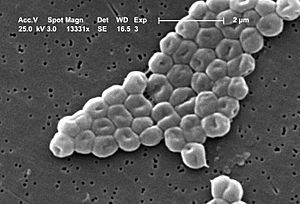Moraxellaceae facts for kids
Quick facts for kids Moraxellaceae |
|
|---|---|
 |
|
| Acinetobacter baumannii | |
| Scientific classification |
|
| Domain: | Bacteria |
| Phylum: | Proteobacteria |
| Class: | Gammaproteobacteria |
| Order: | Pseudomonadales |
| Family: | Moraxellaceae Rossau et al. 1991 |
| Genus | |
|
Acinetobacter Faucicola |
|
Moraxellaceae (say: moh-rak-sell-AY-see-ee) are a group of tiny living things called bacteria. You can only see them with a microscope! They are known as "gram-negative" bacteria. This is a way scientists classify bacteria based on their cell walls. Some Moraxellaceae can cause sickness in people and animals.
What are Moraxellaceae?
Moraxellaceae are a family of bacteria. They are very small, single-celled organisms. Scientists group them based on how they look and act. One special feature is that they are "gram-negative." This means they do not hold a certain purple stain in a lab test. This test helps scientists identify different types of bacteria.
What do they do?
Some bacteria in the Moraxellaceae family are pathogens. This means they can cause diseases. For example, a type called Moraxella catarrhalis can cause breathing problems in people. It can make conditions like Chronic obstructive pulmonary disease worse.
Another type, Moraxella bovis, affects animals. It causes an eye infection in cattle. This infection is often called "pink eye" in cows. It makes their eyes red and sore.
How are Moraxellaceae grouped?
Scientists use a system called Systematics to group living things. This helps them understand how different organisms are related. The Moraxellaceae family belongs to a larger group called Gammaproteobacteria.
This family includes several different types, or genera, of bacteria. Each genus has its own unique features. Here are some of the main genera found within the Moraxellaceae family:
- Acinetobacter
- Alkanindiges
- Branhamella
- Enhydrobacter
- Moraxella
- Paraperlucidibaca
- Perlucidibaca
- Psychrobacter
These different groups of bacteria are studied by scientists. They learn about where they live and what they do. This helps us understand how to treat diseases they might cause.
See also
 In Spanish: Moraxellaceae para niños
In Spanish: Moraxellaceae para niños

